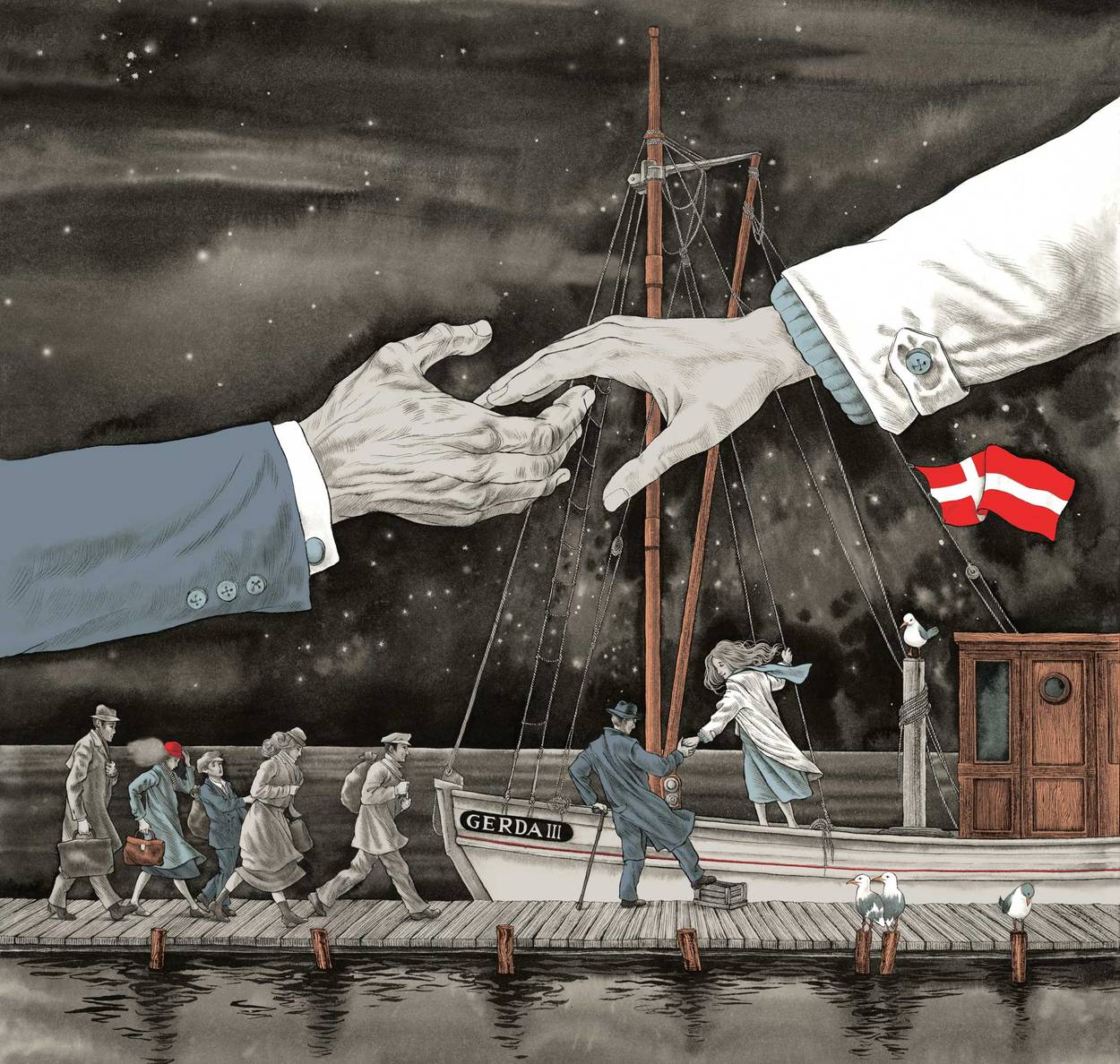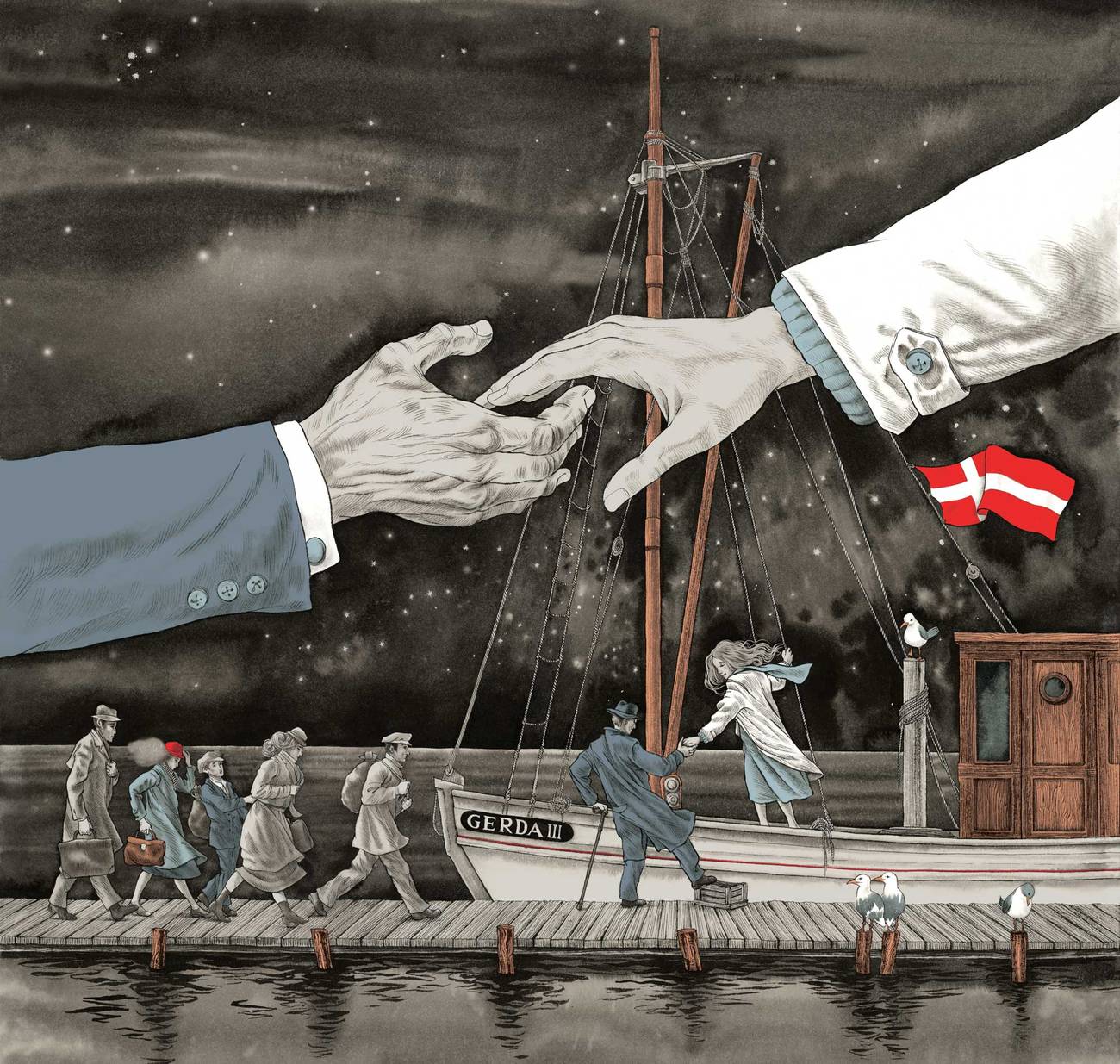After over 1,400 Israelis were murdered on Oct. 7, U.S. Special Antisemitism Envoy Deborah Lipstadt called the attacks “the most lethal assault against Jews since the Holocaust.” One week later, during one of the darkest weeks in decades for Jewish people around the world, a new exhibit opened at New York’s Museum of Jewish Heritage–A Living Memorial to the Holocaust that is meant to inspire hope. Courage to Act: Rescue in Denmark tells the story of 7,000 Jewish refugees and the Danish and Swedish communities who helped them survive.
“Today, I would say more than ever, even in the midst of war and terror, this is an opportunity to remember that there are always good people who do good things,” said Ellen Bari, the museum’s project director and curator. “And this is a shining example of them.”
While the exhibit had been planned for years, some could say there has never been a more opportune time than this week for its debut. The interactive exhibit commemorates—through archival materials, photographs, recordings, testimonials, and other artifacts—one of the most effective and exceptional instances of mass resistance to antisemitism in modern history, which took place 80 years ago.
Over the course of three weeks in October 1943, more than 7,000 Danish Jews—or over 95% of all Jews within Denmark during the Nazi occupation, plus about 700 non-Jewish spouses and relatives—were ferried in secret to safety in Sweden, escaping deportation to concentration camps and almost certain death. Using around 300 vessels, from fishing boats to kayaks, members of the Danish Resistance Movement, as well as ordinary Danes, worked with local fishermen to transport the passengers to neutral Sweden, which welcomed them, providing refuge. And once the war was over, Denmark was the anomaly among European countries, welcoming back its Jewish population with open arms. Around 500 Danish Jews didn’t make the journey to Sweden and were deported to the Theresienstadt ghetto. All but about 50 survived the Holocaust. “The story is not well known, even among the Jewish community,” said Bari. “This felt like the perfect opportunity to think about new ways to educate young people about the Holocaust, and to take this as an example of how a nation responded differently than any of the other countries.”
The subject isn’t the only thing that’s novel about Courage to Act; it is also the museum’s first exhibit geared specifically toward children, as young as 9. Discussing atrocities with children feels painful and somewhat impossible for caregivers. (Right now, for instance, many of those taking care of young ones are at a loss for what to say about the Hamas attacks—how to explain such horrors to children.) While there are an overwhelming number of Holocaust stories to be told, this one was chosen for its focus on resilience and collective action. “In this exhibit, instead of focusing on the atrocities, we focus on the positive, on people really standing up for their neighbors, and as survivors,” said Bari.
When visitors first enter the exhibit, they encounter a wall with a message of support. “Some of the stories in this exhibition are about hatred, violence, and murder,” it says. “If you feel scared, or sad, you can take a break. Try taking a few deep breaths or talking with an adult.” As visitors continue, it becomes more and more palpable how thoroughly the designers of this exhibit tried to ensure it’s as comprehensive as humanly possible for children—and adults. A list of “important terms” are outlined, not taking it for granted that any visitor knows the definitions of “Holocaust,” “occupation,” “ghettos,” and “concentration camps.” It even defines “Judaism.”
“The reality is that there’s almost no children’s exhibition where a child comes without an adult,” said Bari. “And we definitely cannot assume that the adults accompanying children, wherever they come from, have any of that information. So we really had to take a big step backward, and think, ‘What do we have to define?’ And how we can do it in simple strokes.”
The role of collaboration took on a new meaning with this exhibition. In addition to designers and curators, the museum brought in children and teens during the creation of the exhibit to help ensure it would not only make sense for kids, but that it would be meaningful. Fifth graders at PS 276, across the street from the museum, joined their teacher, Dawn Panebianco, in reviewing and marking up the scripts, pointing out references they didn’t understand and making recommendations for edits so that other children would fully grasp the exhibition. “We really tried to make this exhibit effective for ages 9 to 99,” said Bari. “You’ll notice that none of the photos are of atrocities. But we’re not glossing over the story.”
The exhibit not only explains, at an age-appropriate level, what happened, but how to make sense of it. “Standing up for what is right is as important today as it was then,” it says. “This chapter of history reminds us that the choices we make can change the world.”
Traditionally, Holocaust education begins a bit later for most children, closer to the teen years. Yet, now, more than ever, it feels necessary to begin educating at a younger age, said Jack Kliger, president and CEO of the museum: “I think that kids today grow up a lot faster than before, and know a lot more about the world around them,” he said. “The assumption that kids at ages 9 or 10 are making moral choices is a new parameter. So for us to pick a subject that made sense for that effort was very important.”
Kliger wanted this exhibit to help change the narrative from what museumgoers are used to seeing from Holocaust education. “The idea of agency, people taking on their own well-being and rescue is important, and not told enough,” he said. “Jewish agency, resilience, and resistance are much more prevalent than people realize. But for me, this story is about what collective action can be, rather than just individual.”
Leo Goldberger—who was personally rescued by the Danes, and is the inspiration behind one of the characters featured in the exhibit—stressed the importance of educating young children about Holocaust history. “I believe children can understand and accept more than we think,” he said. “This exhibit is a good opportunity to begin speaking with kids about racial discrimination and hatred. I don’t think we should hide that from children.” After surviving the Holocaust, Goldberger went on to become a distinguished psychologist, author, and editor known for his work in sensory deprivation, stress, and coping.
An illustration by Sveta Dorosheva in ‘Courage to Act: Rescue in Denmark’COURTESY THE MUSEUM OF JEWISH HERITAGE - A LIVING MEMORIAL TO THE HOLOCAUST
The need and desire among educators to have age-appropriate Holocaust education materials have grown in recent years. Judy Batalion, who published a book in 2021 about female resistance fighters in the Holocaust, was approached by her publisher to adapt her book for young readers. At first, she couldn’t imagine how it would be done, but she thought back to her initial reason for wanting to create her book in the first place. “What inspired me to write my book in the first place was learning about Hannah Senesh in the fifth grade,” said Batalion. “All of the research for my book was inspired by my experience learning about this one young Jewish woman when I was 11 years old. It’s so important to teach young children about resistance, resilience, dignity, defiance and strength.”
While she’s not affiliated with the museum exhibit, Batalion said she is inspired by the idea of it, and hopes it has great reach. “On a broad level, I hope it makes children interested in learning more about the Holocaust, and that it makes them feel more compassionate for others,” she said. “I hope it makes children feel not afraid to ask questions, and most importantly, I hope it inspires children to resist.”
Historian Therkel Stræde, an adviser to the Courage to Act exhibit, hopes that this example will help shift the narrative from what we’re used to seeing from the Holocaust, and inspire the younger generation to stand up for what’s right. “The Danish events—an example of a Jewish population that was saved to almost 100% from Nazi persecution—were an exception to the Holocaust,” he said. “The Danish case underlines the fact that a decision could be made, even in a situation of extreme asymmetry of power, to side with the oppressed. Almost every Danish man and woman who got the chance to be of help to the rescue efforts, chose to do so; even children took responsibility and participated.” A father to a 12-year-old himself, Stræde hopes that the exhibit provides space for intergenerational exchange about how even in the darkest of times, we can do good.
As a reporter, I wasn’t sure that the exhibit would open as planned, or if my previously scheduled interviews would change due to the tragedies unfolding in Israel. But as I toured the exhibit, and watched people line up to give thoughtful, emotional interviews, I understood—as a parent—why this exhibit opening would never be delayed. “In the past week, the exhibit has become more relevant than ever,” said Kliger. “The understanding of antisemitism has evolved. It’s no longer just a bunch of extreme religious fanatics, or people who hate Jews. There’s a more modern, nefarious form of antisemitism that needs to be looked at. And so, fighting antisemitism is more necessary than ever before.”


